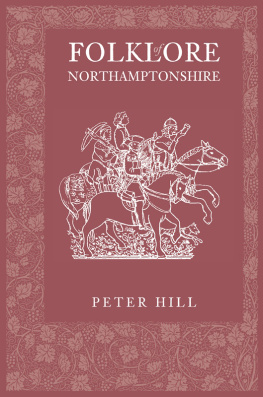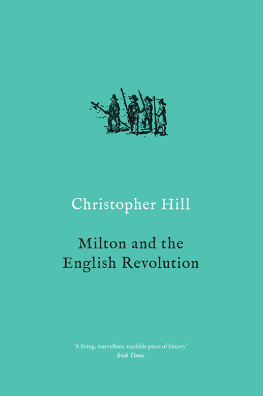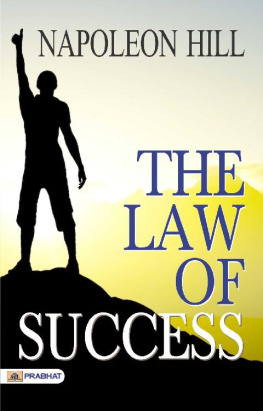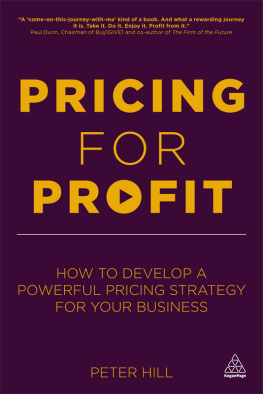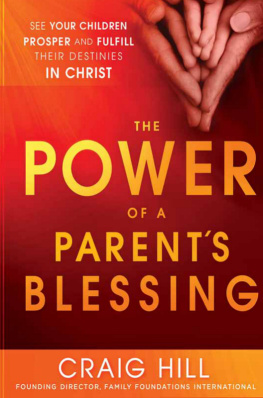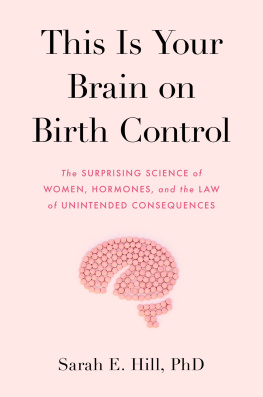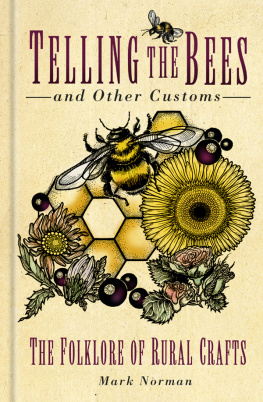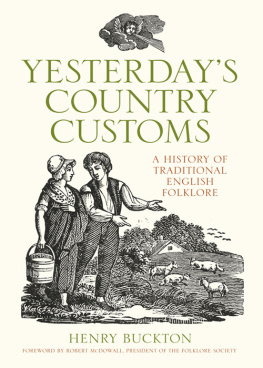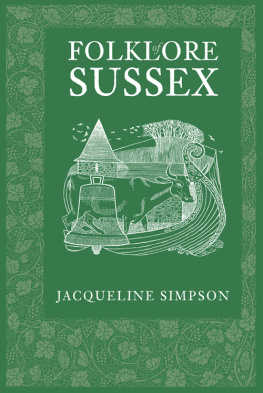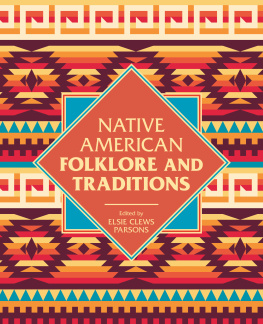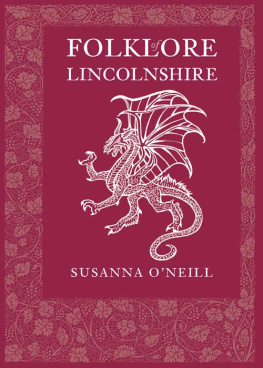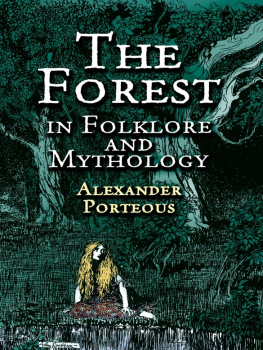FOLKLORE
of
NORTHAMPTONSHIRE

FOLKLORE
of
NORTHAMPTONSHIRE
PETER HILL

Frontispiece: The county of Northamptonshire as it is today. At one time, part of Stamford, and the Soke of Peterborough, were within its boundaries. Changes have been made since the nineteenth century, the last being those which took place in the 1970s. It is still unique in being surrounded by eight other counties.
First published 2005
This edition first published 2009
Reprinted 2012
The History Press
The Mill, Brimscombe Port
Stroud, Gloucestershire, GL5 2QG
www.thehistorypress.co.uk
This ebook edition first published in 2013
All rights reserved
Peter Hill, 2005, 2009, 2013
The right of Peter Hill to be identified as the Author of this work has been asserted in accordance with the Copyright, Designs and Patents Act 1988.
This ebook is copyright material and must not be copied, reproduced, transferred, distributed, leased, licensed or publicly performed or used in any way except as specifically permitted in writing by the publishers, as allowed under the terms and conditions under which it was purchased or as strictly permitted by applicable copyright law. Any unauthorised distribution or use of this text may be a direct infringement of the authors and publishers rights, and those responsible may be liable in law accordingly.
EPUB ISBN 978 0 7524 9987 1
Original typesetting by The History Press
C ONTENTS
A CKNOWLEDGEMENTS

I am grateful to the many people who have helped in getting the material for this book. In addition to those named in context for answering my many questions, allowing me access to various archives, private correspondence, diaries, research notes and information intended for publication which never made the final hurdle, I wish to thank Rachel Watson, Sue Groves, Sarah Bridges and the other archivists at the County Record Office for their assistance over the years; the Public Record Office; the Law Society; the staff at Northampton Museum and Peterborough Museum; Rothwell Heritage Centre and Wellingborough Heritage Centre. A word of special thanks is given to Terry Bracher and Colin Eaton of the Local Studies Collection at Central Library, Northampton for access to relevant parts of the John Clare collection and permission to use extracts from the manuscripts; Jo Langley at Corby Library; the staff at Daventry, Brackley, Towcester and Oundle Libraries; Oundle Museum; Manor House Museum at Kettering; Cambridgeshire Record Office; Leicestershire Record Office; and my former associates at the University of East Anglia.
The work of John Clare, Anne Elizabeth Baker, Thomas Sternberg, Christopher Markham and John Askham, all of whom recorded vital aspects of folklore and life, both current and fast disappearing at the time they were writing, is also duly recognised.
I would like to express a particular word of thanks to the following individuals for their help past and present: Gareth Fitzpatrick on behalf of the Duke of Buccleuch, Hugh de Capell Brooke, Gertrude Bagshaw, Jack Bailey, Harold Bazely, Annie Beaver, Burl Bellamy, Mia Butler, Rose Clark, John Clarke, Flo Colyer, George Deacon, Colin Elliott, Frank Ellis, Edna Essex, Norah Field, Alan Fookes, Maurice Goodwin, John Green, Dorothy Grimes, Jim Harker, Elsie Harrison, Audrey Harwood, John and Gwen Hay, Carl Hector, Robin and Hilary Hillman, Judy Hopkins, Elizabeth Jordan, Pat Kimmons, Matthew Kirk, R.C. Lambeth, Adela Lock, Lance Lock, Mavis Maltby, Norman Mason, Bob Mears, Ron Mears, Alan Milton, Robert Newman, C.J. Ough, David Pain, Edith Palmer, Tom and Jane Parker, Sue Payne, Charles Peach, Connie Pickford, Marian Pipe, Mary Pittam, Harry Pywell, Monica Raine, Bill Richardson, Paul and Yasmin Rogers, Peter Rowney, Elvin Royall of the Rothwell Spoken Archive, Mabel Sculthorp, Beryl and Bill Simon, Audrey Singlehurst, Michael Smith, Reg Sutton, Commander Michael Saunders Watson, Alice Thomas and Mervyn Wilson.
I would like to mark my appreciation and admiration for the unknown photographers and illustrators of the past whom I have been unable to contact, who in many cases recorded something which has long since vanished. My gratitude also goes to Ron Mears, R. Lambeth, Carl Hector, Charles Herbert, Monica Raine and others whose work I have used in this book.
A debt of gratitude is also owed to the many local history societies around the county for whom I have given lectures, and the students on my courses who have given imput from their own experiences, family memoirs and other sources.
A special mention must be given to the many people I have interviewed over the years, most of whom were open and warm in their recollections to someone they hardly knew at first meeting, especially those who were in their eighties and nineties (though even in their time, much had already disappeared), and in particular to one special lady, who was born in the 1870s and died in 1969, who many years ago inspired my interest in folklore and history when I was very young. They were the last links with a world we have lost and it was a special privilege to share those priceless memories with them and to record their experiences, which might never have been written down and would have remained irretrievable. In some cases, they were inspired to personally write down their memoirs for members of their family both present and future, a task that in some ways rolled back the years, and gave them a chance to relive their youth.
Last but not least, my sincere thanks to Katherine Burton of Tempus Publishing for her interest in getting this, my fourth book for the company, into print; and to my family for their patience and understanding while I turned the home into a press office until the project came to fruition.
I NTRODUCTION

I f such an appliance as a time machine existed and we could go back to the past and see the county as it was 100, 200 or more years ago, most visitors would find it hard to come to terms with what they saw, heard and experienced. Accustomed to having a wide variety of consumables to choose from and the ability to afford them, having a substantial home with a range of utilities and a personal means of travelling from place to place as and when they want, it would not be an exaggeration to say they would be unable to tolerate or survive the lifestyle of our ancestors. Equally, if our ancestors could visit our world, they would also be shocked, not so much at the way the world has changed visually and made progress in science, medicine and technology, but by seeing the modern emphasis on money and success, the number of cars and the fast, stressful pace of life. They worked hard but they played hard too they were survivors and they had a vivid, colourful vocabulary, a superstitious mind and a range of customs, all of which helped them through the good and bad times of life.
Northamptonshire lies almost in the centre of England, stretching north-east to south-west, its shape likened variously to an oak leaf or a deflated balloon. Being surrounded by eight other counties has left it open to so many influences, which have affected its vocabulary and folklore. It is a county of contrasts, with miles of green and well-watered rolling countryside and river valleys punctuating the landscape, making it an attractive proposition for settlement ever since mankind came on the scene. Two of the countys rivers rise in the Naseby area: the Nene, which flows eastwards into The Wash, and the Avon, which meanders westwards through Shakespeare country and beyond. The older dwellings in the county have been constructed either with golden or honeycomb-coloured ironstone or the more durable grey Jurassic limestone, celebrated also for its use in the construction of the original St Pauls Cathedral and Kings College Chapel in Cambridge, among other great buildings.
Next page
